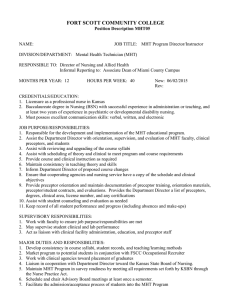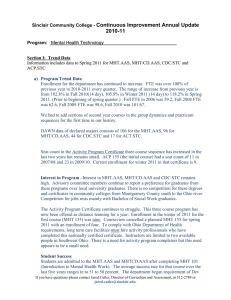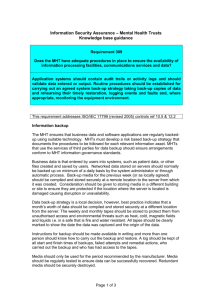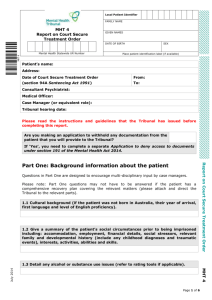Continuous Improvement Annual Update 2011-12
advertisement
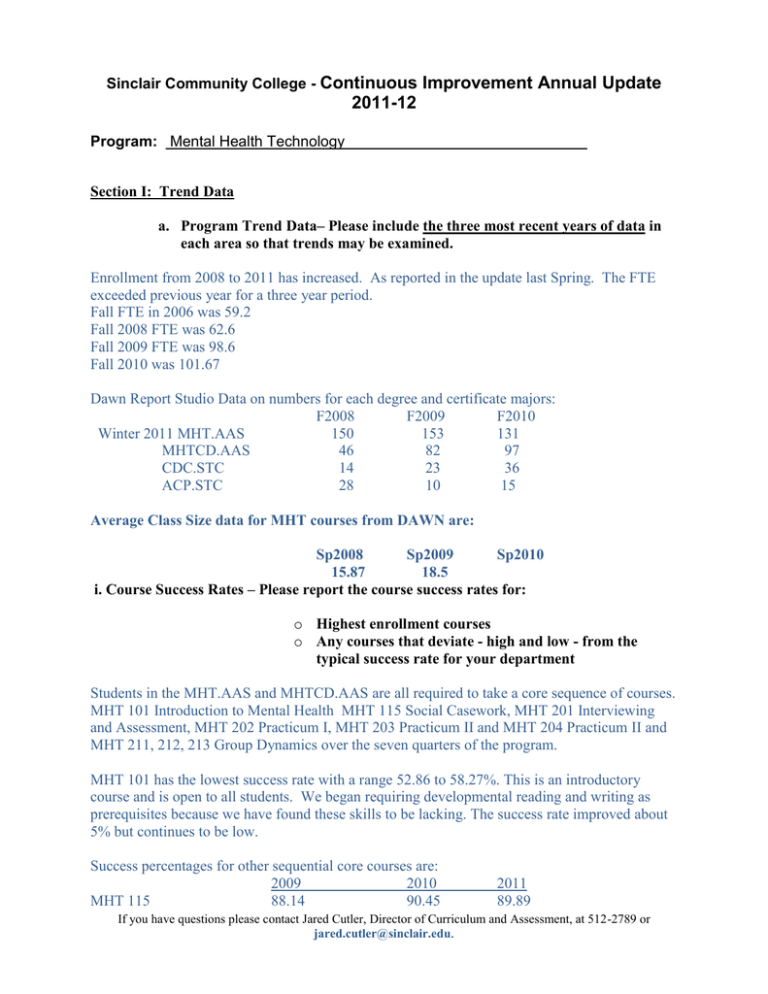
Sinclair Community College - Continuous Improvement Annual Update 2011-12 Program: Mental Health Technology Section I: Trend Data a. Program Trend Data– Please include the three most recent years of data in each area so that trends may be examined. Enrollment from 2008 to 2011 has increased. As reported in the update last Spring. The FTE exceeded previous year for a three year period. Fall FTE in 2006 was 59.2 Fall 2008 FTE was 62.6 Fall 2009 FTE was 98.6 Fall 2010 was 101.67 Dawn Report Studio Data on numbers for each degree and certificate majors: F2008 F2009 F2010 Winter 2011 MHT.AAS 150 153 131 MHTCD.AAS 46 82 97 CDC.STC 14 23 36 ACP.STC 28 10 15 Average Class Size data for MHT courses from DAWN are: Sp2008 Sp2009 Sp2010 15.87 18.5 i. Course Success Rates – Please report the course success rates for: o Highest enrollment courses o Any courses that deviate - high and low - from the typical success rate for your department Students in the MHT.AAS and MHTCD.AAS are all required to take a core sequence of courses. MHT 101 Introduction to Mental Health MHT 115 Social Casework, MHT 201 Interviewing and Assessment, MHT 202 Practicum I, MHT 203 Practicum II and MHT 204 Practicum II and MHT 211, 212, 213 Group Dynamics over the seven quarters of the program. MHT 101 has the lowest success rate with a range 52.86 to 58.27%. This is an introductory course and is open to all students. We began requiring developmental reading and writing as prerequisites because we have found these skills to be lacking. The success rate improved about 5% but continues to be low. Success percentages for other sequential core courses are: 2009 2010 MHT 115 88.14 90.45 2011 89.89 If you have questions please contact Jared Cutler, Director of Curriculum and Assessment, at 512-2789 or jared.cutler@sinclair.edu. MHT 201 MHT 202 MHT 203 MHT 204 77.97 84.85 96.67 100 93.44 92.16 100. 100 87.32 92.45 87.50 100 The highest success rate is in our final quarter of the degree. MHT 204 Practicum III has a success rate of 100% for the past three years. ii.Degree and certificate completion (where applicable) Degree completion numbers are as follows: 2008-2009 MHT.AAS 17 MHTCD.AAS 8 2009-2010 29 6 2010-2011 29 17 Completion of short term certificates are: Activity Program 14 Chemical Dependency 1 iii. 14 8 6 1 Any additional data that illustrates what is going on in the program (examples might include course sequence completion, retention, demographic data, data on placement of graduates, graduate survey data, etc.) Success in the first course of our Group Dynamics sequence of three courses improved from 73.17% in 2008-09 to 86.79% 2010-2011. The instructor made some course revisions in quantity of work involved in assignments. This reduction appeared to improve success in the course without compromising quality. b. Interpretation and Analysis of Trend Data Included in the Section Above Suggestions of questions that might be addressed in this section: What trends do you see in the above data? Are there internal or external factors that account for these trends? What are the implications for the program or department? What actions have the department taken that have influenced these trends? What strategies will the department implement as a result of this data? Some of the information is repeated from last spring Program Update. Enrollment is strong and has increased over the last two years. We have been told by the provost that historically enrollment increases just before conversion from quarters to semesters and that enrollment then drops just after the conversion. Enrollment then tends to stabilize as time passes. This phenomena may be one affecting our department. If you have questions please contact Jared Cutler, Director of Curriculum and Assessment, at 512-2789 or jared.cutler@sinclair.edu. We continue to be one of the few Life and Health Sciences departments that is not restricted in enrollment by accreditation or other factors. We have been able to accommodate the growth by adding sections of degree courses, offering distance learning courses in Activity Program and planning with Courseview to offer the Activity Program Certificate and the Chemical Dependency Certificate. If Courseview can provide a group lab classroom at their facility we plan to expand the MHT degree program in Fall 2013. We did experience a record high for students entering second year practicum (MHT 202) Fall 2011. Initially 74 students reported they planned to take practicum. Until Fall 2010 we had three sections of practicum with a maximum of 16 per section. So we could easily accommodate 48 students. We added an additional section in Fall of 2010 and Fall 2011. However that only accommodates 64 students. We also have limitations on agencies available to accept our students for this experience. We discussed this issue with Dr. David Collins and fortunately did not have to find more sites. Several students changed their intentions and four sections met the needs of the second year students. In reference to low success in MHT 101 and MHT 140, we are also looking forward to seeing if the required “How to Succeed in an Online Course.” will effect the success in our online sections. Success in online MHT 101 is 20% lower that face to face classes. Also we see many student writing skills are poor. In reviewing several sections of students in MHT 101 from Spring and Summer 2011, almost half had not returned to the college the following quarter. Success in the remaining courses is high. The increase and decrease in percentages for MHT 202, 203 and 204 can reflect a change of only one or two students because these courses have a cap of 16. Section II: Progress Since the Most Recent Review a) What was the fiscal year of the most recent Program Review for this program? 2007-2008 b) Briefly summarize the goals that were listed in Section IV part E of the most recent Program Review Self-Study (this section of the Self-Study asks “What are the department’s/program’s goals and rationale for expanding and improving student learning, including new courses, programs, delivery formats and locations”)? Goal: Continuous review of assessment process and data. Goal: Increase courses at Courseview and the learning centers. Goal: Offer chemical dependency and activity program certificate courses through distance learning. Goal: New course(s) in motivational interviewing c) What Recommendations for Action were made by the review team to the most recent Program Review? If you have questions please contact Jared Cutler, Director of Curriculum and Assessment, at 512-2789 or jared.cutler@sinclair.edu. 1. Regarding transfer: o Initiate new collaborations with baccalaureate degree programs at universities in the region to facilitate transfer of students, and establish written articulation agreements. o Include transfer as part of the departmental mission. 2. The department is strongly encouraged to more fully explore the issues that lead to poor performance in MHT 101 and evaluate how to improve retention and success within that course. While possible solutions might include pre-requisites, a placement questionnaire and online course development were discussed. Any decisions regarding action should be supported by data, which can be provided to the department by Research, Analytics and Reporting upon request. 3. While the numbers and types of assessment are commendable, the next step is to better ‘close the loop’ – apply findings to make changes in program, curriculum and/or service, and reassess the impact of changes. The department is encouraged to document the changes made to program outcomes or the curriculum as a result of assessment and to report these changes in annual updates and the next self-study report. 4. Explore the feasibility of offering the program in Warren County. 5. With revision of the institution’s website, revise marketing efforts for programs, using EMAS for marketing and recruitment. 6. Review the projected ACS with actual and adjust projections to more accurately reflect actual. 7. More aggressively pursue the use of part time faculty. d) Have the goals in your self-study changed since your last Program Review Self-Study as a result of the Review Team recommendations or for any other reason? If so, please describe the changes. Yes. Some goals have been completed, others have moved to another level. e) What progress has been made toward meeting any of the goals listed in the sections above (b, c, and d) in the past year? If you have questions please contact Jared Cutler, Director of Curriculum and Assessment, at 512-2789 or jared.cutler@sinclair.edu. Part b: Goal: Continuous review of assessment process and data. o We have struggled with this goal. We took several years just determining the best valid measures of learning for our program outcomes. We have not followed through well with closing the loop. The changes in the assessment process have been positive for our program. See the assessment section of this document. Goal: Increase courses at Courseview and the learning centers. o We have increased courses at Courseview and now offer the complete chemical dependency short term certificate. We are planning to offer both AAS degrees at Courseview beginning Fall 2012. Goal: Offer chemical dependency and activity program certificate courses through distance learning. We now offer the activity program certificate through distance learning. Distance learning has not been receptive to offering the chemical dependency certificate. I have approached them through several avenues until last year whe the CD curriculum for semesters was converted and the goal was on hold. Goal: New course(s) in motivational interviewing o This course has been offered through the department for three years. Part c: 1. Transfer is now part of our department mission statement. We have initiated contact with Wright State University Department of Social Work and Rehabilitation Counseling, Capital University Department of Social Work, College of Mount St. Joseph Department of Social Work (Cincinnati), Brescia University Department of Social Work, Indiana Wesleyan Department of Addictions, University of Cincinnati Department of Addiction Studies. We currently have no written articulation agreements. But graduates have transferred to all of the aforementioned programs with the exception of College of Mount St. Joseph and Indiana Wesleyan. Goal for this academic year: Provide all these colleges with our semester curriculum and courses descriptions and request written articulation agreements. In addition we are working with Kelly Vogelsong to develop a booklet for the colleges and universities to help with transfer of our students. We have provided the division with information on all programs that accept our graduates and are part of the divisional articulation plan. 2. We have made some progress in this goal. (Explanation is in Section 1A). 3. This is a goal in progress. We spent the first few years of the assessment process working on a valid tool. We are still in the process of closing the loop. The plan is to measure every program outcome every year. We will then concentrate on the outcomes that need the most attention. More information is available in the assessment section of this document. 4. We are offering all Chemical Dependency Certificate courses at Courseview and we are planning to offer MHT.AAS and MHT/CD.AAS beginning Fall 2012. If you have questions please contact Jared Cutler, Director of Curriculum and Assessment, at 512-2789 or jared.cutler@sinclair.edu. 5. MHT has been working with Kelly Vogelsong on preparing material to take to Career Fairs. We now have a display and some posters. 6. Average class size has increased to 19.2 in Spring 2011. 7. We added three new adjunct faculty in 2010-2011 and one additional faculty for the Fall of 2011. If you have questions please contact Jared Cutler, Director of Curriculum and Assessment, at 512-2789 or jared.cutler@sinclair.edu. Section III: Assessment of Outcomes The Program Outcomes for this program are listed below. At least one-third of your program outcomes must be assessed as part of this Annual Update, and across the next three years all of these program outcomes must be assessed at least once. Mental Health Technology Program Outcomes In which courses are these program outcomes addressed? Which of these program outcomes were assessed during the last fiscal year? MHT 201 1) Accurately gather information through clinical interviews and observation. MHT 204 Assessed in last fiscal Year 2011-2012 2) Assess and prioritize client needs. MHT 204 Plan to Asses 20112012 MHT 204 Plan to Assess 20112012 3) Plan effective intervention strategies. 4) Demonstrate interventions to meet client needs. 5) Establish/maintain effective therapeutic relationships with others. 6) Demonstrate professional and ethical practice with a sensitivity to and respect for cultural, ethnic, and life style differences. MHT 202, 203 and 204 MHT 204 MHT 204 Assessed in last fiscal year 2010-2011 7) Demonstrate effective self awareness and self-management. MHT 213 8) Facilitate group interactions reflecting a knowledge and understanding of group dynamics. MHT 204 9) Demonstrate effective oral and written reporting skills. 10) Demonstrate an understanding of the dynamics and patterns contributing to the development of an individual’s current functioning. MHT 204 Plan 2011- to asses 2012 Assessment Methods Used Mean scores for intake and Rubric administered to practicum supervisor Rubric administered to practicum supervisor Rubric administered to practicum supervisor Rubric administered to practicum supervisor Rubric administered to practicum supervisor Rubric administered to practicum supervisor Rubric administered to practicum supervisor and completed by each student Rubric completed by course instructor. Rubric administered to practicum supervisor Rubric administered to practicum supervisor If you have questions please contact Jared Cutler, Director of Curriculum and Assessment, at 512-2789 or jared.cutler@sinclair.edu. For the assessment methods listed in the table above, what were the results? Completing a departmentally developed rubric for each outcome, practicum supervisors evaluate these outcomes at the agency for each MHT 204 Practicum student. MHT 204 is our capstone course. 29 rubrics were returned by the agency supervisors. Outcome 1: Accurately gather information through clinical interviews and observation. Average Score: 8.224 Faculty are pleased with this average. Outcome2: Assess and prioritize client needs. Average score: 8.396 Faculty are pleased with this average. Plan: Ask advisory committee for directions on what we should be teaching in reference to prioritizing client needs in the Mental Health System. Revise instruction and assignments accordingly. Outcome 7: Demonstrate effective self awareness and self management. (time management, taking initiative, dependability, open and responsive to feedback, awareness of counter-transference issues, clear boundaries, seeks supervision.) Average score: 8.465 Faculty are pleased with this average. We have examples of self awareness and self management. However we have a number of examples or factors that are included in the outcome. Plan: Create a survey to be completed by students and supervisors to identify which factors may need to be addressed. The department has determined two changes in data collection. We will be collecting data on all program outcomes on an annual basis. We will benchmark a desired score for each outcome. . Improvements implemented: Outcome 1: Accurately gather information through clinical interviews and observation Faculty have shared power points used for instruction of intake and psychsocial databases in Fall 2011. We will share powerpoint for Mental Status instruction in Winter 2012. We will compare mean scores for these assignments from 2010-2011 with 2011-2012 to see if there is improvement. Our goal is to improve the mean score by three points. We If you have questions please contact Jared Cutler, Director of Curriculum and Assessment, at 512-2789 or jared.cutler@sinclair.edu. also would expect an improvement in the supervisor completed rubric for this item of a minimum of .3 points on the likert scale. Outcome 2: Assess and prioritize client needs The faculty discussed improvement in instruction on our treatment planning assignments which are the primary assignments connected with this outcome. We have a treatment planning course and also have treatment planning assignments in MHT 203 and MHT 204. We will be standardizing our instruction for this outcome in MHT 203 in Winter 2012. We discussed community expectations of this outcome with agency representatives at our spring advisory committee meeting and implemented their feedback in our instruction of treatment planning. Re evaluating this outcome will take place in MHT 203 and 204 in Spring 2012. We will compare mean scores for treatment plan assignments from 2010-2011 to 2011-2012 as well as the scores for supervisor completion of rubric. Outcome 7: Demonstrate effective self awareness and self management. The department plans on having students self evaluate on this outcome as well as others. This will enable the student to personally identify areas where they can improve. The faculty will also identify assignments that address this outcome and discuss changes in those assignments can improve the score on the likert scale. a) Were changes planned as a result of the data? If so, what were those changes? Changes are included in previous section. b) How will you determine whether those changes had an impact? Outcome 1: Our goal is to improve the mean score of the intake and psychosocial database assignments by three points from previous year. Also an improvement on supervisor rubric of .3 Outcome 2: Our goal is to improve mean score for treatment plan by three points from previous year. Also an improvement on supervisor rubric of .3. Outcome 7 Faculty can compare student self evaluation with agency supervisor score. After assignments have been reviewed and instructional changes made, the faculty will expect a .3 improvement on the supervisor rubric. We also need to determine if these instruments are providing us with the data we need. c) Starting with next year’s Annual Update, this section will ask about assessment of general education outcomes. For FY 2012-13, you will be asked how the department is assessing Oral Communication and Written Communication in your courses, and in addition you will be asked to share the results of those assessments. Please be prepared to address this in next year’s Annual Update. If you have questions please contact Jared Cutler, Director of Curriculum and Assessment, at 512-2789 or jared.cutler@sinclair.edu. c) Does your department have courses where there are common assignments or exams across all sections of the course? If so, please list those courses, and indicate whether you are currently examining results across all sections of those courses. We have common assignments in MHT 115, 201, 202, 203, 204, 205 211, 212, 213 and 245. Some of these courses have the same instructor and that instructor has informally in the past looked at mean scores for the assignments across sections. We are now in the process of improving standardization of assignments in the practicum sequence(MHT 202, 203 and 204). See previous section. We have always used the same checklist for scoring assignments in these courses so we are focusing on standardizing instructional methods at this point. We are also planning on a process to standardize courses taught by adjuncts. We have met with the adjuncts and have received positive response to the plan. I have been given access to COM 206 shell that is used for adjuncts in the communications department so that our department can begin use this tool as a model to move toward improving adjunct knowledge of expectations in every course. The process will include having full time faculty who teach a the course populate the Angel shell for adjuncts. We will not implement any plans until we are in semesters due to curriculum changes that will occur at that time. This is a time intensive project and full time faculty will have to make a plan for prioritizing courses and completing the Angel course shells. Section IV: Improvement Efforts for the Fiscal Year a) FY 10-11: What other improvement efforts did the department make in FY 10-11? How successful were these efforts? What further efforts need to be made? If your department didn’t make improvement efforts during the fiscal year, discuss the strengths and weaknesses of the department over the last year and how the department plans to address them in the coming year. b) The department completed the curriculum revisions for semester and have begun Mapping our admitted students. We also are reviewing all MHT 101 students from Spring 2011 through Spring 2012 to make sure they are on track for completion of the academic goals. These tasks have taken the bulk of our time. We have added a few new practicum sites and have lost a few sites due to economy. We added a new tenure track faculty and lost an ACF position. Our strengths include a cohesive faculty team and student centered philosophy. Our weakness has been “closing the loop” on assessment. I believe for the first time this year we have understood and implemented some changes that show we are getting there. If you have questions please contact Jared Cutler, Director of Curriculum and Assessment, at 512-2789 or jared.cutler@sinclair.edu. c) FY 11-12: What improvement efforts does the department have planned for FY 11-12? How will you know whether you have been successful? We plan to concentrate on transfer agreements to universities. The goal is to have discussion of transfer with a minimum of five universities. We will be planning the semester schedule and faculty needs. Projections for numbers of sections and faculty will meet the needs of students in fall semester 2012. We will focus on assessment changes listed in assessment section of this document. See previous section for expectations. Questions regarding completion of the Annual Update? Please contact the Director of Curriculum and Assessment at 512-2789 to schedule a time to review the template and ask any questions. If you have questions please contact Jared Cutler, Director of Curriculum and Assessment, at 512-2789 or jared.cutler@sinclair.edu.
